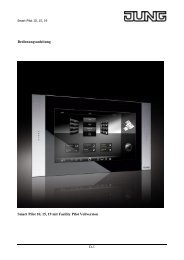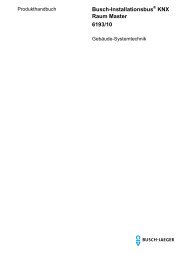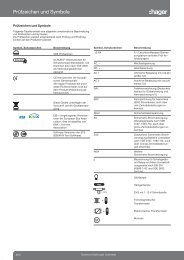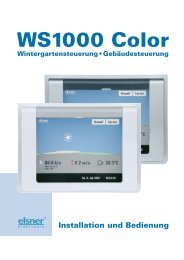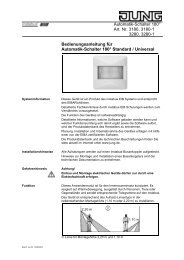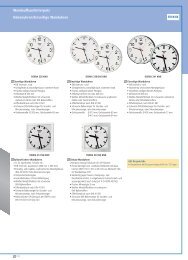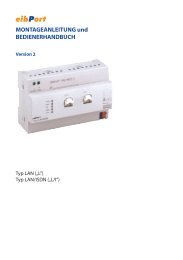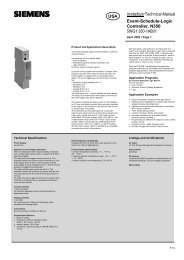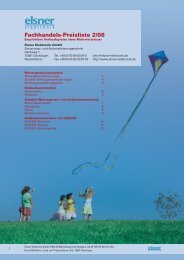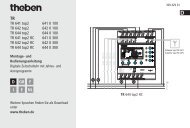You also want an ePaper? Increase the reach of your titles
YUMPU automatically turns print PDFs into web optimized ePapers that Google loves.
The "Value display" parameter specifies the type of the communication object and the valid<br />
value range. With a 1 byte object matching Type 5,001...5,004, the value to be transmitted can<br />
be configured as an integer (0 … 255), a percentage (0 … 100%) or an angle(0 … 360°). With<br />
all the other data point types, the entered value is transmitted immediately.<br />
The telegram is then transmitted via a separate button object.<br />
If the display element is configured for the display function "Value", then the function buttons<br />
can be also be configured for the function "Value display of the display element". In this case,<br />
the "Value function" parameter specifies whether a constant value is transmitted on each actuation<br />
or whether the user can edit the value on the panel later. In the former case, the constant<br />
value is specified with the next parameter. In the latter case, a minimum value and a maximum<br />
value are entered in the parameter configuration. If the user enters a value later using the onscreen<br />
numeric keypad or a slider, there will be a test to see if the value is within the specified<br />
limits. If this is not the case, the appropriate minimum or maximum value is used. If the display<br />
element is modified using the "Offset" and "Reinforcement" parameters before being shown on<br />
the screen, this calculation is also used on the button function before the new value is transmitted.<br />
In the case of the function "Value display of the display element", the function button affects the<br />
communication object of the display element and not a separate object.<br />
Light scene:<br />
When the button is actuated, one of the internally managed light scenes is opened. The parameter<br />
"Light scene" specifies which light scene is opened. The light scenes must be created in<br />
the ETS plug-in in the parameter node "Light scene -> Light scene collection -> Light scene<br />
page ..." before they can be selected using the "Light scene" parameter.<br />
Restraint:<br />
With this button function, two communication objects are visible. The parameter "Button function"<br />
specifies which of the two communication objects is to transmit a telegram. The possible<br />
settings are...<br />
No function: no telegram is transmitted.<br />
On: the 2 bit object transmits a telegram with which restraint is deactivated. The 1 bit object<br />
transmits a switch-on telegram.<br />
Off: the 2 bit object transmits a telegram with which restraint is deactivated. The 1 bit object<br />
transmits a switch-off telegram.<br />
Toggle: the 2 bit object transmits a telegram with which restraint is deactivated. The value of the<br />
1 bit object is inverted and transmitted.<br />
Restraint ON: the 2 bit object transmits a telegram with which causes switch-on with a higher<br />
priority. The value of the 1 bit object is not relevant, it does not transmit a telegram.<br />
Restraint OFF: the 2 bit object transmits a telegram with which causes switch-off with a higher<br />
priority. The value of the 1 bit object is not relevant, it does not transmit a telegram.<br />
Restraint off: the 2 bit object transmits a telegram with which restraint is deactivated. The 1 bit<br />
object does not transmit a telegram.<br />
The telegram is transmitted via a separate button object.<br />
If the display element is configured for the display function "Restraint", then the function buttons<br />
can be also be configured for the function "Restraint function of the display element". In this<br />
case, the function button affects the communication objects of the display element and not separate<br />
elements.<br />
Open page:<br />
If "Open page" is set as the function of a button, the parameter "Jump to page" can be used to<br />
specify which page is displayed when the button is actuated. The parameter "Jump to page" offers<br />
a list with the user pages currently created in the project, the pages predefined in the system<br />
and the presetting "Return".<br />
When a page is opened, the system notes on which page it is opened. The "Return" automatically<br />
switched back to this page. Only the last page is ever saved. If "Return" is entered on two or<br />
more pages, it may cause the function to jump between these pages.<br />
If a password level is assigned to a page and the page to be opened has a higher password<br />
level, the new password of the higher level must be entered using the on-screen numeric<br />
keypad before the switch is made. If an incorrect password is entered, the page change is not<br />
Order-No. 7574 00 1X<br />
Software "...590101"<br />
Functional description<br />
Page 62 of 222




